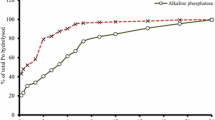Summary
While monitoring the changes in mineral N status during incubation, it was observed that the magnitude and rate of N mineralization directly depended on organic C and total N contents in the alkaline soils. Nitrogen mineralization started since the beginning of incubation in all except the Hansi and Karnal soils which showed a lag of seven days. Since these two soils were of high electrical conductivity (EC) and gypsum requirement (GR), and N mineralization in them started immediately after the amendment with gypsum, it was concluded that the lag was due to the depressive effects of high amount of toxic salts on microorganisms involved in N mineralization.
The gypsum-amended soil samples released more NH4-N and NO3-N than the unamended ones. Beneficial effects of gypsum on N mineralization in the soils was thought to be due to stimulation of microorganisms and/or neutralization of toxic salts thereby creation of a favourable habitat for them. A rate of gypsum rendering the maximum mineral N release was considered as “optimum”. re]19760518
Similar content being viewed by others
References
Agarwal, A. S., Singh, B. R. and Kanehiro, Y., Ionic effect of salts on mineral nitrogen release in an allophanic soil. Soil Sci. Soc. Am. Proc. 35, 454–457 (1971).
Allison, F. E. and Sterling, L. D., Nitrate formation from soil organic matter in relation to total nitrogen and cropping practices. Soil Sci. 67, 239–252 (1949).
Bremner, J. M., Inorganic forms of nitrogen.In C. A.Black et al. (Ed.) Methods of Soil Analysis, Pt. 2, American Society of Agronomy, Inc., Madison, Wisconsin, 1179–1237 (1965).
Greaves, J. E., The influence of salts on the bacterial activities of the soil. Soil Sci. 2, 443–480 (1916).
Greaves, J. E., Carter, E. G. and Goldthorpe, H. C., Influence of salts on the nitric-nitrogen accumulation in the soil. J. Agric. Res. 16, 107–135 (1919).
RankovV., Effect of gypsum and fertilizer on microflora of saline soils. Izv. Inst. Pochvoznan. Agrotekh. ‘Pushkarov’ 8, 203–212 (1963).In Soils Fert.27, 1508 (1964).
Rankov, V., Effect of applying gypsum and fertilizers to saline soils on the rhizosphere microflora of millet. Rast. Nauki. 1, 31–38 (1964).In Soil Fert.28, 2456 (1965).
Rankov, V., Effect of applying gypsum and fertilizers on ammonification and nitrification in saline soils. Mikrobiologiya 36, 144–149 (1967).
Author information
Authors and Affiliations
Rights and permissions
About this article
Cite this article
Singh, B.R., Taneja, S.N. Effects of gypsum on mineral nitrogen status in alkaline soils. Plant Soil 48, 315–321 (1977). https://doi.org/10.1007/BF02187243
Received:
Issue Date:
DOI: https://doi.org/10.1007/BF02187243




